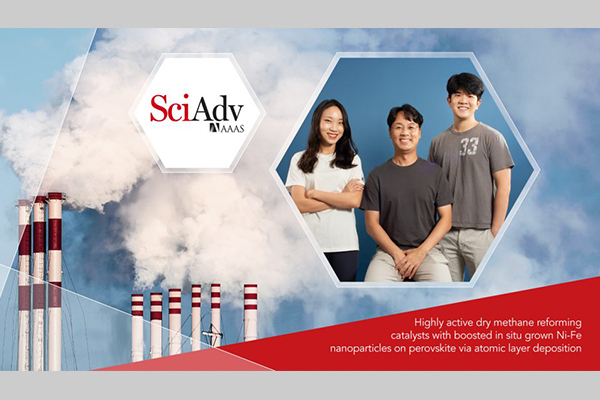Oct 27 2020
Researchers have created a new nanocatalyst that can be used to recycle major greenhouse gases, such as methane (CH4) and carbon dioxide (CO2), into extremely valuable hydrogen (H2) gas.
 A research team, led by Professor Gun-Tae Kim in the School of Energy and Chemical Engineering at UNIST has developed a new nanocatalyst that recycles major greenhouse gases, such as carbon dioxide (CO2) and methane (CH4), into highly value-added hydrogen (H2) gas. Image Credit: UNIST.
A research team, led by Professor Gun-Tae Kim in the School of Energy and Chemical Engineering at UNIST has developed a new nanocatalyst that recycles major greenhouse gases, such as carbon dioxide (CO2) and methane (CH4), into highly value-added hydrogen (H2) gas. Image Credit: UNIST.
It is expected that the new catalyst will significantly contribute to the advent of many waste-to-energy conversion technologies. This is because it has over twice the conversion efficiency from CH4 to H2 than the traditional electrode catalysts.
Led by Professor Gun-Tae Kim in the School of Energy and Chemical Engineering at Ulsan National Institute of Science and Technology (UNIST), a group of researchers has formulated a new technique to improve the stability and performance of catalysts used in the reaction (i.e., dry reforming of methane, DRM) that synthesizes H2 and carbon monoxide (CO) from major greenhouse gases, such as CH4 and CO2.
Nickel (Ni)-based metal complexes are catalysts used conventionally for the dry reforming of methane (DRM). However, after a period of time, the performance and service life of the catalysts degrade.
This is due to the accumulation of carbon on the surface of the catalysts, as the catalysts cluster together or their reaction takes place multiple times at a higher temperature.
The uniform and quantitatively controlled layer of iron (Fe) via atomic layer deposition (ALD) facilitates the topotactic exsolution, increasing finely dispersed nanoparticles.
Sangwook Joo, Combined MS/PhD, Study First Author, School of Energy and Chemical Engineering, UNIST
Moreover, the researchers established that exsolution is facilitated even with tiny amounts of ALD-deposited Fe oxide (Fe2O3).
Notably, at 20 cycles of Fe oxide deposition via ALD, the particle population reaches over 400 particles (Ni-Fe alloys). As these particles are composed of Ni and Fe, they also exhibited high catalytic activity.
Arim Seong, Combined MS/PhD, Study Co-First Author, School of Energy and Chemical Engineering, UNIST
The new nanocatalyst showed high catalytic activity for the DRM process without any evident degradation in performance for over 410 hours of nonstop operation. The results also revealed a high methane conversion (more than 70%) at 700 °C.
This is more than twice the power conversion efficiency that of the conventional electrode catalysts. Overall, the abundant alloy nanocatalysts via ALD mark an important step forward in the evolution of exsolution and its application to the field of energy utilization.
Gun-Tae Kim, Professor, School of Energy and Chemical Engineering, UNIST
The study results have been reported in the August 26th, 2020, issue of the Science Advances, a sister journal of Science. This study has been collaboratively performed by Professor Jeong Woo Han from POSTECH, Professor John M. Vohs, and Professor Raymond J. Gorte from the University of Pennsylvania, USA.
Journal Reference:
Joo, S., et al. (2020) Highly active dry methane reforming catalysts with boosted in situ grown Ni-Fe nanoparticles on perovskite via atomic layer deposition. Science Advances. doi.org/10.1126/sciadv.abb1573.